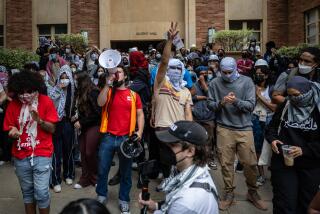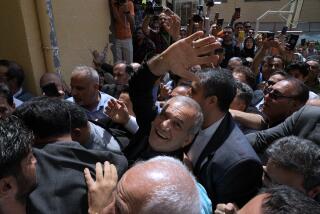Iran’s opposition spreads to heartland
Reporting from Beirut — Mohammad knew he had to be careful in approaching his old classmate Hamed, the one from the conservative Iranian family. They come from a small city, after all, and word gets around.
When they ran into each other last summer in their eastern Iranian hometown of Birjand, the pair hadn’t seen each other for nine years. As they caught up on old times, the conversation turned to the country’s disputed election in which President Mahmoud Ahmadinejad defeated challenger Mir-Hossein Mousavi.
“He believed Ahmadinejad’s victory was not fraudulent, and that Mousavi was angry because Iranians didn’t vote for him,” said Mohammad, a 23-year-old engineering student in Birjand, a provincial capital of 160,000 near the border with Afghanistan. “He also thought that the people who protest are some gangsters and not civilized people.”
A clever and highly ambitious young man whose dream until seven months ago was to go abroad, get rich and have drinks by a pool in Miami, Mohammad found himself drawn into political activism after the election -- and trying to recruit friends and acquaintances to join him.
Defying the predictions of some who dismissed it as a phenomenon limited to big cities, the “green” opposition movement appears to have spread to the heartland, with video and credible reports emerging from towns in the provinces.
Activists such as Mohammad are the foot soldiers, discreetly reaching out to people in small, tightknit communities that don’t enjoy the anonymity of Tehran.
For months the spotlight has been concentrated on the capital: Not only do international news organizations remain in Tehran, but the constant hubbub in the metropolis of 12 million makes it easier for protesters to head into the streets and then make it home without being identified by security forces.
But in smaller cities such as Birjand, the police, intelligence officers and allied militiamen have a much easier time recognizing protesters.
The activists take enormous risks. Five large military bases guard Birjand, regarded as the springboard for Revolutionary Guard anti-drug operations along the eastern border.
But it also has five universities and four colleges, making it a potential opposition stronghold. More than 60% of Iranians are younger than 30, and 70% of college students reportedly opposed Ahmadinejad.
Immediately after the election results were announced, angry residents took to the streets of Birjand, as they did in cities across the country. Security forces charged the crowds and dragged away alleged ringleaders and a professor, Mohammad-Reza Agha-Ebrahimi.
“So protests were a failure at the beginning,” Mohammad said.
But the opposition movement didn’t die, thanks largely to activists such as Mohammad, whose last name is not being published for security reasons.
Mohammad and his friends step carefully. They speak with their parents, relatives and friends, and ask them to encourage co-workers at their offices or at the city’s tire plant, tile factory, cement plant or soft drink producer to at least have sympathy for a movement led by their sons and daughters.
“We wear green, we act green,” Mohammad said. “We express our beliefs in public.”
A computer whiz with spiky hair who earns extra cash selling fancy cellphones, he now risks getting kicked out of school and thrown into prison for being an activist.
“If you asked me last year, I would probably say, ‘My dream is to go abroad for my master’s degree and try for a foreign passport,’ ” he said. “But now, my only dream is our victory against the dictatorship, and to gain my own freedom.”
His account of what has happened over the last seven months in Birjand, corroborated by former and current residents of the city, and consistent with reports from other small cities around the country, illustrates how the opposition movement has gained a foothold nationwide.
In places such as Birjand, universities have led the way. After the election, the Islamic associations on all Birjand campuses began printing political statements distributed by student activists to classmates, cabbies, restaurant employees and fellow bus passengers. Students began organizing small gatherings at their universities. They publicly demanded freedom for the professor, Agha-Ebrahimi.
He was released.
Students spray-painted graffiti on walls. “Death to the dictator!” they scrawled with green markers on phone booths, just as in the capital. Some went to jail. One of Mohammad’s friends was sentenced to nine months in prison for distributing leaflets.
In the classrooms, professors lifted students’ spirits by discussing the Islamic Republic’s missteps, and what sorts of protest actions were effective and which were counterproductive.
One professor spoke to students about the difference between real and superficial freedom.
“He said something like, ‘We are free to breathe, but not free to live; and not being free to live, we’re dead, actually,’ ” Mohammad recalled.
The students followed the news on opposition websites and via BBC Persian and Voice of America, which can be picked up more easily in small cities and the countryside than in Tehran, where the government jams international satellite signals.
They learned to avoid having political conversations over the phone or using text messages to organize meetings for fear of the prying eyes of security forces. They have mastered the use of proxy servers to get access to banned websites as well as shield their surfing habits from surveillance technology.
Still, it’s an uphill battle to persuade others to risk life and liberty by speaking out.
“They feel that they’re not seen,” he said. “They’re not heard, and whatever they do for justice is going to be like an unheard sound.”
At first, in his talks with onetime classmate Hamed, Mohammad acted as if he had no particular stake in the issue of Iran’s election battle. But over tea and during walks, he began voicing the points of the opposition.
“I talked to him about people’s rights, dictatorship and Islamic fascism,” he recalled. “I set him straight about the history of the government’s sins after the Islamic Revolution.”
Then Mohammad handed Hamed a DVD that showed violent confrontations involving security forces and left him alone. Mohammad said most government supporters are not people who can be convinced simply by talking.
“I let him do his own research,” he said. “There are many other people I talked to, but I’m not sure whether they changed or not.”
The young people of Birjand looked forward to taking part in street protests Dec. 7, National Students Day. But as one opposition blog put it, the city was in a state of “undeclared martial law” in the hours before the scheduled demonstrations.
“In all of the streets and squares, Basijis and intelligence officers are on alert,” the blog reported. “In most of the squares the anti-riot police are stationed and patrols can be seen in all of the side streets.”
The demonstrations were foiled.
“Protests like Tehran’s are not possible in low-populated cities, as they need a lot of people,” Mohammad said.
But in the crowd at one aborted protest he spotted a familiar face. It was his old chum Hamed!
Since their last encounter, Hamed had joined the movement and become active on his campus in Abadan, the southwestern city where he studies.
“I had made him believe from the depth of his heart that these murderers are not at the right side,” Mohammad said.
“I found him as green as myself.”
More to Read
Sign up for Essential California
The most important California stories and recommendations in your inbox every morning.
You may occasionally receive promotional content from the Los Angeles Times.










